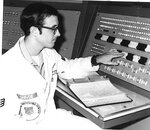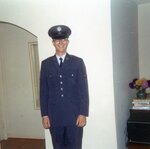Welcome to our new web site!
To give our readers a chance to experience all that our new website has to offer, we have made all content freely avaiable, through October 1, 2018.
During this time, print and digital subscribers will not need to log in to view our stories or e-editions.
Staff Sergeant Theodore L. Spayde
U.S. Air Force
Ted signed up for delayed enlistment in the Air Force on December 14, 1970. He went on active duty and started six weeks of basic training …
This item is available in full to subscribers.
We have recently launched a new and improved website. To continue reading, you will need to either log into your subscriber account, or purchase a new subscription.
If you had a login with the previous version of our e-edition, then you already have a login here. You just need to reset your password by clicking here.
If you are a current print subscriber, you can set up a free website account by clicking here.
Otherwise, click here to view your options for subscribing.
Please log in to continue |
|


Staff Sergeant Theodore L. Spayde
U.S. Air Force
Ted signed up for delayed enlistment in the Air Force on December 14, 1970. He went on active duty and started six weeks of basic training on February 16, 1971, at Lackland AFB, San Antonio, Texas. After completing basic training in April 1971, Ted was assigned to the 2867 GEEIA (Ground Electronics Engineering Installation Agency) Squadron at McClellan AFB, Sacramento, California, as an electronic equipment installer. While at McClellan, he worked on refurbishing a gap filler radar system that would be shipped to South Korea. Ted went to work TDY (Temporary Duty) to install a 50-wire cable between a computer and a printer that were located in separate buildings. In order to better accomplish their mission, Ted’s entire squadron applied for a Top Secret clearance with Extended Background Investigation. Ted was also sent on a three-month TDY to Fallon Naval Air Station at Fallon, Nevada, for on-the-job training on the BUIC (Backup Interceptor Control) Burroughs computer system. This system was a backup to the Q7 computer in Cheyenne Mountain, Colorado, that monitored air traffic on the west coast.
While at Fallon, Ted received his Top Secret clearance and an assignment to Clark AFB, Philippines. Prior to the move, he was sent to Ft. Monmouth in Red Bank, New Jersey, for the Overseas AUTODIN (Automatic Digital Network) computer repair school for six months.
In June 1972, Ted arrived at Clark AFB, in the Philippines, for his new job in computer maintenance at the Clark AUTODIN Switching Center. This was an unaccompanied tour. Ted’s wife Ruth joined him later, but they had to pay for Ruth’s trip themselves, and they had to stay in off-base housing at their own expense.
AUTODIN was a message switch that transferred messages sent from one base to another. Most communications between bases in those days were through the AUTODIN system. Messages could be personal-related (for instance, change of station orders, change of rank orders) or mission-related (i.e., bombing strike orders in Vietnam).
One of Ted and Ruth’s most memorable times was in 1973, when the first POWs were sent home from Vietnam. Clark AFB was the first stop for the returning POWs. People would go to the flight line to watch the POWs being loaded onto buses and ambulances for transportation to the base hospital. You could also meet the POWs when they were taken to the BX (Base Exchange) to shop. Ted and Ruth remember one officer who was talking to all of the 10-year-old boys. He had been in captivity for 10 years and had never seen his son.
Ted’s next assignment was to CCPC (Communications Computer Programming Center) at Tinker AFB, Oklahoma City, Oklahoma. On his way to Tinker in August 1973, their first son, Damon, was born at Whiteman AFB, Missouri. Ted’s job at CCPC was writing test and diagnostic programs for the AUTODIN computer system as a Computer Maintenance Programmer/Analyst. Ted designed and coded an AUTODIN Failure Analysis program which would predict which equipment combinations were likely to cause problems in the future so that preventative actions could be taken before failure. Ted also assisted in the design and coding of the AUTODIN Magnetic Tape and Tape Controller diagnostic. Since there was no AUTODIN computer at Tinker AFB, several TDYs were required for the testing and debugging of the programs at Ft. Dietrich in Frederick, Maryland.
Ted was again assigned to the Clark AB AUTODIN Switching Center in the Philippines, and he started his duties there in September 1975. Ted and Ruth were worried they would miss the Bicentennial celebrations in the US in 1976, but memories of the celebration activities that took place at Clark will be with them forever.
In August 1977, Ted and his family traveled to their last assignment at CCPC on Tinker AFB, Oklahoma City, Oklahoma. Their second son, Kirby, was born just after they arrived at Tinker. During his time at CCPC, Ted was the lead programmer in the AUTODIN Reader/Punch Card and Printer AUTODIN Philco Ford 102 Model Processor diagnostic. As before, several TDYs to Ft. Dietrich, Maryland, were required to test and debug programs.
Ted received his honorable discharge from the Air Force on November 18, 1978.
For his service, Ted received the National Defense Service Medal, Republic of Vietnam Gallantry Cross Medal w/Palm, Philippines Presidential Unit Citation, Air Force Longevity Service Award, Air Force Good Conduct Medal, and the Air Force Outstanding Unit Award.
Comments
No comments on this item Please log in to comment by clicking here